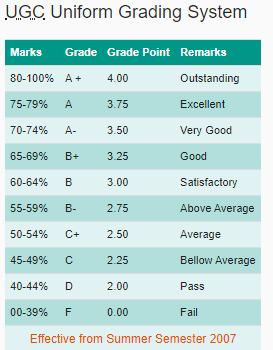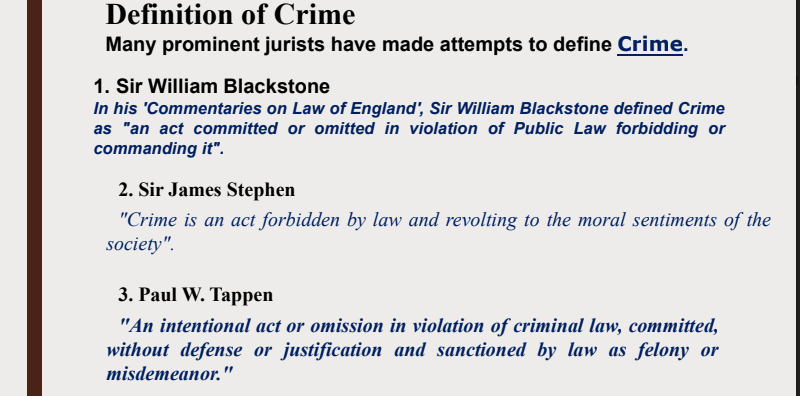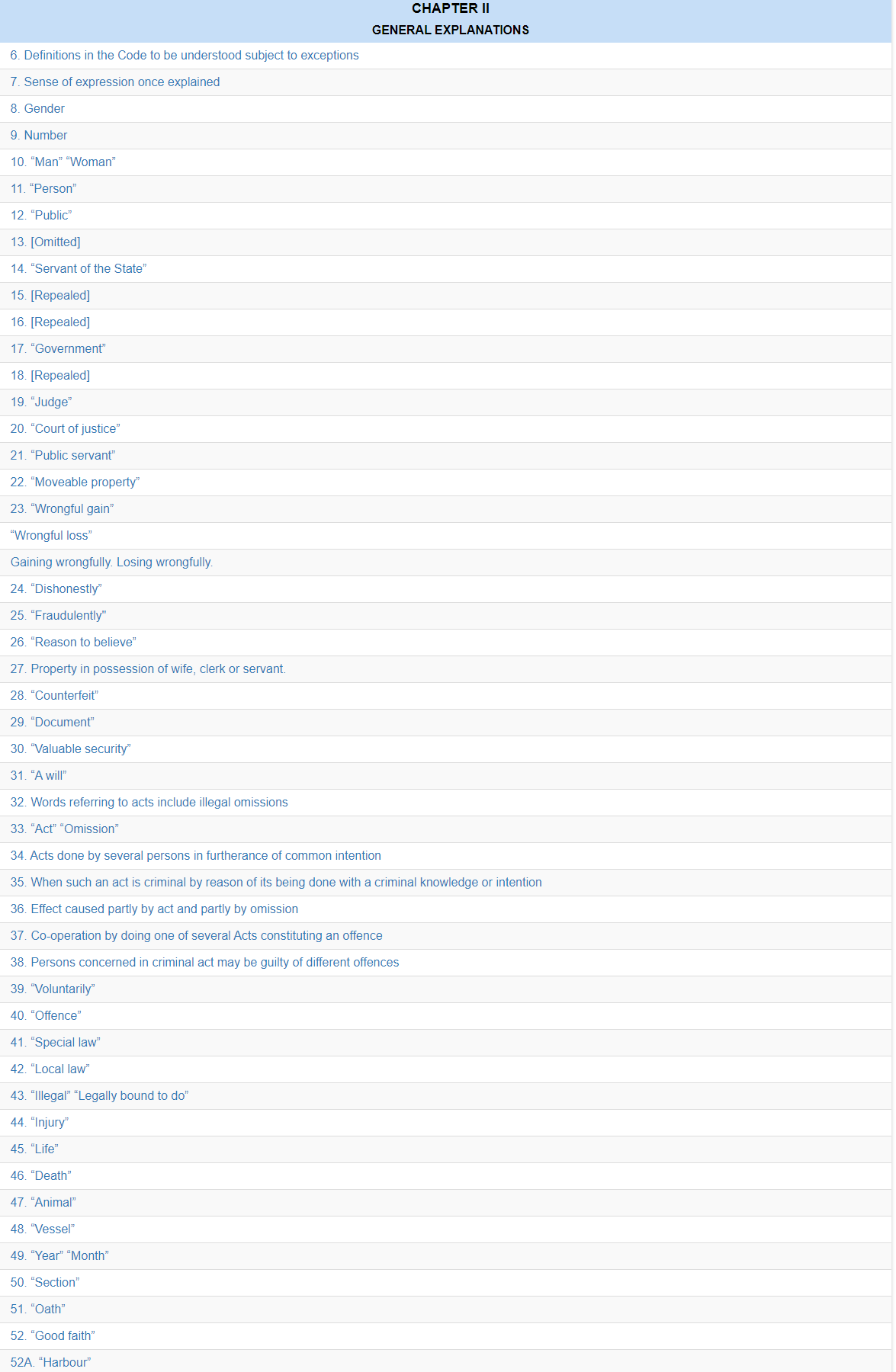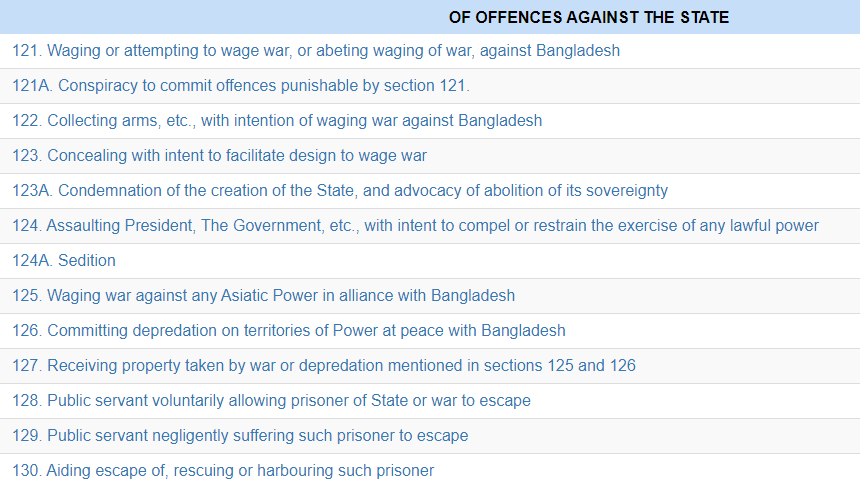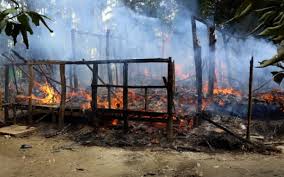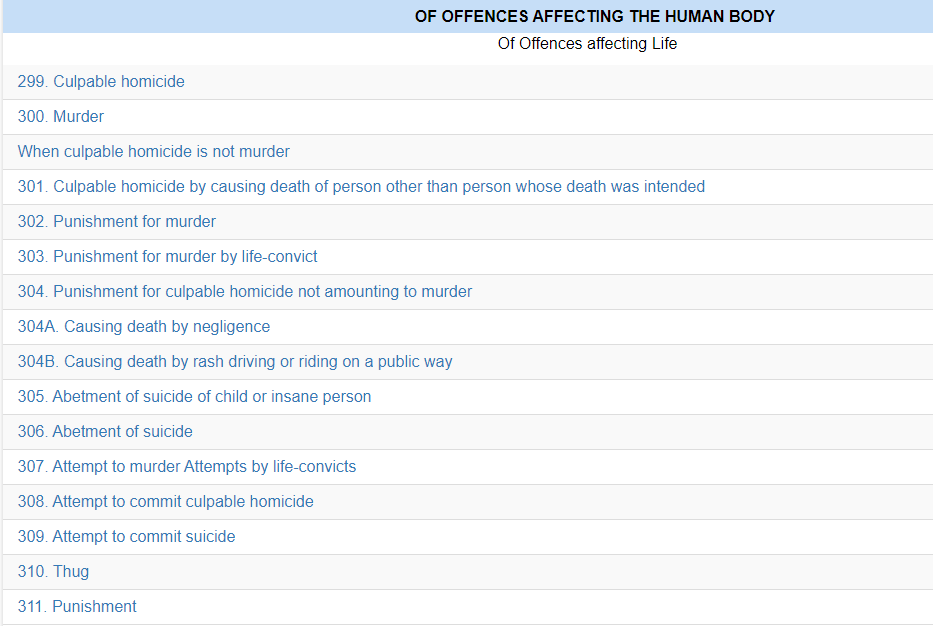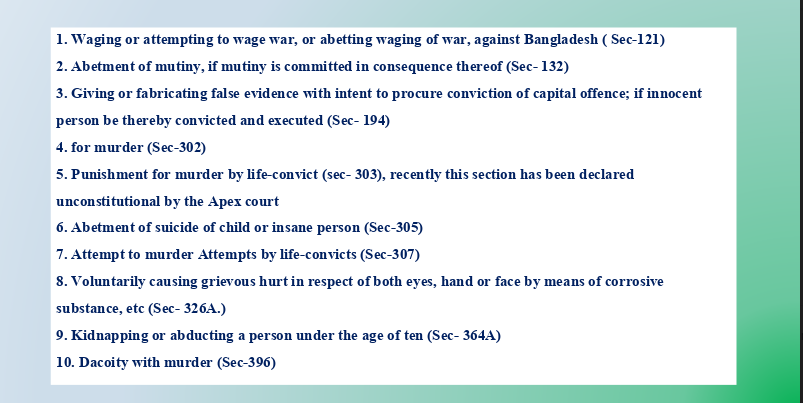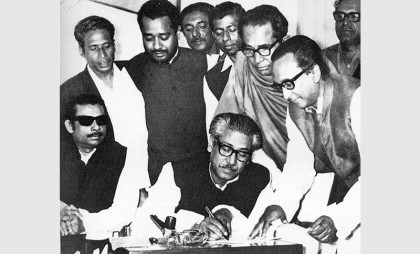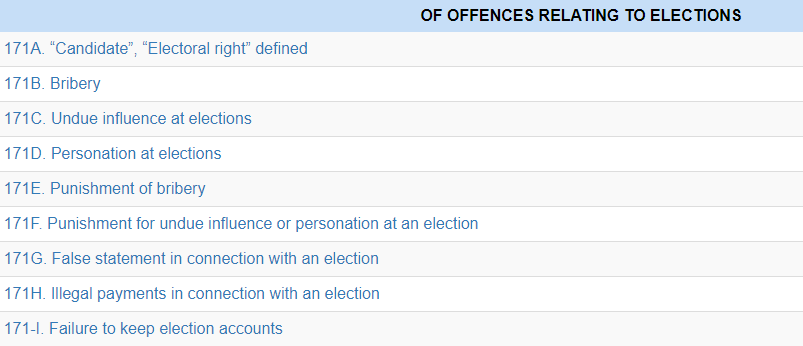| Section | Name | Description |
|---|---|---|
ASSESSMENT PLAN1. Attendance & Participation -07marks |
||
E-Books for referencing, citing and studying in Summer 2020Dear learners ,Assalamualikum and greetingsThis books will help you in addition to my lecture slides, videos, and other supporting materials |
||
|
||
|
||
| Lesson One and Introduction to Basic Concepts of Law of Crime , Criminal Law, and Criminal Administration of Justice | ||
Objectives and learning insights of the Law of Crimes I Criminal Law-II has two parts. One part focuses on the general principles of criminal liability and the other on the criminal procedure. The two parts have been thoughtfully designed to provide a clear understanding of the basic principles and procedure in the operations of criminal law and their role in preventing crime and promoting justice. The primary objective of criminal law is to maintain law and order in society and to protect the life and liberty of people. It is for this reason that the people place their ultimate reliance on this branch of law for protection against all injuries that human conduct can inflict on individuals and institutions. Due to these reasons, the penal law cannot afford to be weak, ambiguous or ineffective. Nor can it be harsh and arbitrary in its impact. The application of criminal law has to be uniform regardless of any discrimination on grounds of class, caste, religion, sex or creed etc. of either the criminal or the victim. The subject of Criminal Law-II has been so designed as to generate critical thinking among the students about the stated objectives of criminal law and enable them to scrutinize the recent developments and changes that have taken place in the field. The Code of Criminal Procedure contains the machinery for the investigation of crime, apprehension of suspected persons, and the imposition of suitable punishment on the guilty. It is further aimed at trying to provide a balance between the needs of the investigating and adjudicatory bodies to detect crime, maintain law and order, and the rights of the accused. With the increasing complaints regarding abuse of powers of arrest by the police, custodial torture and death, denial of bail, etc., the course particularly focuses on investigation, arrest, bail and principles of a fair trial. The provision relating to plea bargaining has been included in the course not only because it is new but also to critically examine the operations under the criminal law which may be oppressive unless all the stakeholders are equally positioned.The principle of mens rea has undergone change with increasing recognition of the distinct nature of socio-economic offenses and the need to deal with them differently. The distinction between a mistake of fact and mistake of law and exclusion of mistake of law as a defense is basic to criminal law practice. It further belies the principle of men's rea by imposing liability on people who had no knowledge or intention to commit an offense. In direct contrast is the right of private defense which arises from the natural instinct of self-preservation where the state protection is not available but has certain well-defined limits on its operation. The principle of group liability has acquired added importance with the increase in organized crime and communal violence. A clear understanding between preparation, attempt, and commission of a crime is indispensable before imposing criminal liability. State’s right to prevent people from taking their own lives, as much as it prevents them from taking the lives of others is definitely a great concern to discuss. |
||
|
||
Objectives and learning insights of the Law of Crimes IThe primary objective of criminal law is to maintain law and order in society and to protect the life and liberty of people. It is for this reason that the people place their ultimate reliance on this branch of law for protection against all injuries that human conduct can inflict on individuals and institutions. Due to these reasons, the penal law cannot afford to be weak, ambiguous or ineffective. Nor can it be harsh and arbitrary in its impact. The application of criminal law has to be uniform regardless of any discrimination on grounds of class, caste, religion, sex or creed etc. of either the criminal or the victim. The subject of Criminal Law-II has been so designed as to generate critical thinking among the students about the stated objectives of criminal law and enable them to scrutinize the recent developments and changes that have taken place in the field.Criminal Law-II has two parts. One part focuses on the general principles of criminal liability and the other on the criminal procedure. The two parts have been thoughtfully designed to provide a clear understanding of the basic principles and procedure in the operations of criminal law and their role in preventing crime and promoting justice. The principle of mens rea has undergone change with increasing recognition of the distinct nature of socio-economic offences and the need to deal with them differently. The distinction between mistake of fact and mistake of law and exclusion of mistake of law as a defence is basic to criminal law practice. It further belies the principle of mens rea by imposing liability on people who had no knowledge or intention to commit an offence. In direct contrast is the right of private defence which arises from the natural instinct of self-preservation where the state protection is not available, but has certain well defined limits on its operation. The principle of group liability has acquired added importance with the increase in organized crime and communal violence. A clear understanding between preparation, attempt and commission of crime is indispensable before imposing criminal liability. State’s right to prevent people from taking their own lives, as much as it prevents them from taking the lives of others is definitely a great concern to discuss. The Code of Criminal Procedure contains the machinery for the investigation of crime, apprehension of suspected persons, and the imposition of suitable punishment on the guilty. It is further aimed at trying to provide a balance between the needs of the investigating and adjudicatory bodies to detect crime, maintain law and order and the rights of the accused. With the increasing complaints regarding abuse of powers of arrest by the police, custodial torture and death, denial of bail, etc., the course particularly focuses on investigation, arrest, bail and principles of a fair trial. The provision relating to plea bargaining has been included in the course not only because it is new but also to critically examine the operations under the criminal law which may be oppressive unless all the stakeholders are equally positioned. |
||
| Lesson Three :Conceptions of Crime and relevant terms and meaning with takin some insights from History of Criminal Justice in South Asian Countries and the reflection | We will discuss certain terms of crime and its elements
|
|
https://drive.google.com/file/d/1kv44dGnxAYQiNs2Y1tJFpFfJBQmB2yj5/view?usp=sharing |
||
| Lesson Four : History of Criminal Justice Administration and Access to Justice in Bangladesh | Pre-Modern Criminal Justice System in Bangladesh |
|
Pre-Modern Criminal Justice System in Bangladesh |
||
| Class Test Examination No. 1 of Spring 2021 | Dear learners, There is your first online evaluation portion find and do the best from your side |
|
| Lesson Five: Concept of Punishment, Justifications and its Applications in Bangladesh | ||
My dear learners,
|
||
My dear learners, |
||
| Lesson Seven: Abatement and Criminal Conspiracy and Punishments | Abetment under Section 107, PCInstigation, Conspiracy, Aid |
|
JUST CLICK HERE TO WATCH OUR VIDEO CLASS LECTURES SMSHLAW31322062020 |
||
| Lesson Eight: Offenses Against the State in Bangladesh |
|
|
| Presentation and Flip Classes Activities of Spring 2021 | ||
| Lesson Ten: Offences Against Peace and Public Tranquilities in Bangladesh | ||
Introduction |
||
NB: Please ignore some/ if any unexpected video picture portion which unintentionally appears and not relevant towards understanding our lectures |
||
| Lesson Eleven: GIVING FALSE EVIDENCE, FABRICATING FALSE EVIDENCE | False EvidenceSection 191 of the Penal Code explains that giving false evidence means a person bound by oath or express provision of law, to tell the truth, makes a false statement or a statement that he doesn’t believe to be true or believes to be false. False statement or evidence given by a person can be in written form or otherwise (oral or indicative). Section 191 is also known as Perjury under English Perjury Act 191. For example, a matter concerning the handwriting of Z for which Z’s son is called to test the handwriting that whether it is of his father or not. Even after knowing it is not the handwriting of Z he states the opposite in court stating that it is the handwriting of Z. It is a typical offence called perjury. Taking up the same scenario of Z’s handwriting, where his son is called to testify his handwriting but this time his son is not confident and states that although I am not confident that it was not the handwriting of Z; in this situation, his son cannot be held liable under Section 193 of the Penal Code because his intention is not to lie. A copy of the sales deed shown in the court which is edited or fabricated is known as false evidence. Perjury is all about giving false evidence. Lets us take a classic example in which X is bound under oath that he will speak only the truth in respect to a case in which Y is suspect for the charge of murder that took place in Delhi. Now X says that Y was with me in Shimla on 20th May 2019( the date when the murder was committed). But X lies and gives false evidence. It is a clear example of perjury. |
|
Giving false evidence 191. Whoever being legally bound by an oath or by an express provision of law to state the truth, or being bound by law to make a declaration upon any subject, makes any statement which is false, and which he either knows or believes to be false or does not believe to be true, is said to give false evidence. Explanation 1.-A statement is within the meaning of this section, whether it is made verbally or otherwise. Explanation 2.-A false statement as to the belief of the person attesting is within the meaning of this section, and a person may be guilty of giving false evidence by stating that he believes a thing which he does not believe, as well as by stating that he knows a thing which he does not know. Illustrations (a) A, in support of a just claim which B has against Z for one thousand taka falsely swears on a trial that he heard Z admit the justice of B's claim, A has given false evidence. (b) A, being bound by an oath to state the truth, states that he believes a certain signature to be the handwriting of Z, when he does not believe it to be the handwriting of Z. Here A states that which he knows to be false, and therefore gives false evidence. (c) A, Knowing the general character of Z's handwriting, states that he believes a certain signature to be the handwriting of Z; A in good faith believing it to be so. Here A's statement is merely as to his belief, and is true as to his belief, and therefore, although the signature may not be the handwriting of Z, A has not given false evidence. (d) A, being bound by an oath to state the truth, states that he knows that Z was at a particular place on a particular day, not knowing anything upon the subject. A gives false evidence whether Z was at that place on the day named or not. (e) A, an interpreter or translator, gives or certifies as a true interpretation or translation of a statement of document, which he is bound by oath to interpret or translate truly, that which is not and which he does not believe to be a true interpretation or translation. A has given false evidence. Fabricating false evidence192. Whoever causes any circumstance to exist or makes any false entry in any book or record, or makes any document containing a false statement, intending that such circumstance, false entry or false statement may appear in evidence in a judicial proceeding, or in a proceeding taken by law before
a public servant as such, or before an arbitrator, and that such
circumstance, false entry or false statement, so appearing in evidence, may cause any person who in such proceeding is to form an opinion upon the evidence, to entertain an erroneous opinion touching any point material to the result of such proceeding, is said "to fabricate the evidence.”
Illustrations
(a) A puts jewels into a box belonging to Z, with the intention that they may be found in that box, and that this circumstance may cause Z to be convicted of theft. A has fabricated false evidence.
(b) A makes a false entry in his Shop-book for the purpose of using it as corroborative evidence in a Court of Justice. A has fabricated false evidence.
(c) A, with the intention of causing Z to be convicted of a criminal conspiracy, writes a letter in imitation of Z's handwriting purporting to be addressed to an accomplice in such criminal conspiracy, and puts the letter in a place which he knows that the officers of the Police are likely to search. A has fabricated false evidence. Punishment for false evidence193. Whoever intentionally gives false evidence in any stage of judicial proceeding, or fabricates false evidence for the purpose of being used in any stage of a judicial proceeding, shall be punished with imprisonment of either description for a term which may extend to seven years, and shall also be liable to fine; and whoever intentionally gives or fabricates false evidence in any other case, shall be punished with imprisonment of either description for a term which may extend to three years, and shall also be liable to fine.
Explanation 1.-A trial before a Court-martial is a judicial proceeding.
Explanation 2.-An investigation directed by law preliminary to a proceeding before a Court of Justice, is a stage of a judicial proceeding, though that investigation may not take place before a Court of Justice.
Illustration
A, in an enquiry before a Magistrate for the purpose of ascertaining whether Z ought to be committed for trial, makes on oath a statement which he knows to be false. As this enquiry is a stage of a judicial proceeding. A has given false evidence.
Explanation 3.-An investigation directed by a Court of Justice according to law, and conducted under the authority of a Court of Justice, is a stage of a judicial proceeding, though that investigation may not take place before a Court of Justice.
Illustration
A, in an enquiry before an officer deputed by a Court of Justice to ascertain on the spot the boundaries of land, makes on oath a statement which he knows to be false. As this enquiry is a stage of a judicial proceeding, A has given false evidence. Giving or fabricating false evidence with intent to procure conviction of capital offence; if innocent person be thereby convicted and executed194. Whoever gives or fabricates false evidence, intending thereby to cause, or knowing it to be likely that he will thereby cause, any person to be convicted of an offence which is capital by any law for the time being in force, shall be punished with 64[imprisonment] for life, or with rigorous imprisonment for a term which may extend to ten years, and shall also be liable to fine; and if an innocent person be convicted and executed in consequence of such false evidence, the person who gives such false evidence shall be punished either with death or the punishment herein before described. Giving or fabricating false evidence with intent to procure conviction of offence punishable with imprisonment for life or imprisonment195. Whoever gives or fabricates false evidence intending thereby to cause, or knowing it to be likely that he will thereby cause, any person to be convicted of an offence which by any law for the time being in force is not capital, but punishable with 65[imprisonment for life], or imprisonment for a term of seven
years or upwards, shall be punished as a person convicted of that offence would be liable to be punished.
Illustration
A gives false evidence before a Court of Justice, intending thereby to cause Z to be convicted of a dacoity. The punishment of dacoity is 66[imprisonment for life], or rigorous imprisonment for a term which may extend to ten years, with or without fine. A, therefore, is liable to 67[such imprisonment for life] or imprisonment, with or without fine. Using evidence known to be false196. Whoever corruptly uses or attempts to use as true or genuine evidence, any evidence which he knows to be false or fabricated, shall be punished in the same manner as if he gave or fabricated false evidence. Issuing or signing false certificate197. Whoever issues or signs any certificate required by law to be given or signed, or relating to any fact of which such certificate is by law admissible in evidence, knowing or believing that such certificate is false in any material point, shall be punished in the same manner as if he gave false evidence. Using as true a certificate known to be false198. Whoever corruptly uses or attempts to use any such certificate as a true certificate, knowing the same to be false in any material point, shall be punished in the same manner as if he gave false evidence. False statement made in declaration which is by law receivable as evidence199. Whoever, in any declaration made or subscribed by him, which declaration any Court of Justice, or any public servant or other persons, is bound or authorized by law to receive as evidence of any fact, makes any statement which is false, and which he either knows or believes to be false or does not believe to be true, touching any point material to the object for which the declaration is made or used, shall be punished in the same manner as if he gave false evidence. Using as true such declaration knowing it to be false200. Whoever corruptly uses or attempts to use as true any such declaration, knowing the same to be false in any material point, shall be punished in the same manner as if he gave false evidence.
Explanation.-A declaration which is inadmissible merely upon the ground of some informality, is a declaration within the meaning of sections 199 and 200. Causing disappearance of evidence of offence, or giving false information to screen offender- if a capital offence; if punishable with imprisonment for life; if punishable with less than ten years’ imprisonment201. Whoever, knowing or having reason to believe that an offence has been committed, causes any evidence of the commission of that offence to disappear, with the intention of screening the offender from legal punishment, or with that intention gives any information respecting the offence which he knows or believes to be false,
shall, if the offence which he knows or believes to have been committed is punishable with death, be punished with imprisonment of either description for a term which may extend to seven years, and shall also be liable to fine;
and if the offence is punishable with 68[imprisonment for life], or with imprisonment which may extend to ten years, shall be punished with imprisonment of either description for a term which may extend to three years, and shall also be liable to fine;
and if the offence is punishable with imprisonment for any term not extending to ten years, shall be punished with imprisonment of the description provided for the offence, for a term which may extend to one-fourth part of the longest term of the imprisonment provided for the offence, or with fine, or with both.
Illustration
A, knowing that B has murdered Z, assists B to hide the body with the intention of screening B from punishment. A is liable to imprisonment of either description for seven years, and also to fine. Intentional omission to give information of offence by person bound to inform202. Whoever, knowing or having reason to believe that an offence has been committed, intentionally omits to give any information respecting that offence which he is legally bound to give, shall be punished with imprisonment of either description for a term which may extend to six months, or with fine, or with both. Giving false information respecting an offence committed203. Whoever, knowing or having reason to believe that an offence has been committed, gives any information respecting that offence which he knows or believes to be false, shall be punished with imprisonment of either description for a term which may extend to two years, or with fine, or with both.
Explanation.-In sections 201 and 202 and in this section the word "offence" includes any act committed at any place out of Bangladesh, which, if committed in Bangladesh, would be punishable under any of the following sections, namely, 302, 304, 382, 392, 393, 394, 395, 396, 397, 398, 399, 402, 435, 436, 449, 450, 457, 458, 459 and 460. Destruction of document to prevent its production as evidence204. Whoever secrets or destroys any document which he may be lawfully compelled to produce as evidence in a Court of Justice, or in any proceeding lawfully held before a public servant, as such, or obliterates or renders illegible the whole or any part of such document with the intention of preventing the same from being produced or used as evidence before such Court or public servant as aforesaid, or after he shall have been lawfully summoned or required to produce the same for that purpose, shall be punished with imprisonment of either description for a term which may extend to two years, or with fine, or with both. False personation for purpose of act or proceeding in suit or prosecution205. Whoever falsely personates another, and in such assumed character makes any admission or statement, or confesses judgment, or causes any process to be issued or becomes bail or security, or does any other act in any suit or criminal prosecution, shall be punished with imprisonment of either description for a term which may extend to three years, or with fine, or with both. Fraudulent removal or concealment of property to prevent its seizure as forfeited or in execution206. Whoever fraudulently removes, conceals, transfers or delivers to any person any property or any interest therein, intending thereby to prevent that property or interest therein from being taken as a forfeiture or in satisfaction of a fine, under a sentence which has been pronounced, or which he knows to be likely to be pronounced, by a Court of Justice or other competent authority, or from being taken in execution of a decree or order which has been made, or which he knows to be likely to be made by a Court of Justice in a civil suit, shall be punished with imprisonment of either description for a term which may extend to two years, or with fine, or with both. Fraudulent claim to property to prevent its seizure as forfeited or in execution207. Whoever fraudulently accepts, receives or claims any property or any interest therein, knowing that he has no right or rightful claim to such property or interest, or practices any deception touching any right to any property or any interest therein, intending thereby to prevent that property or interest therein from being taken as a forfeiture or in satisfaction of a fine, under a sentence which has been pronounced, or which he knows to be likely to be pronounced by a Court of Justice or other competent authority, or from being taken in execution of a decree or order which has been made, or which he knows to be likely to be made by a Court of Justice in a civil suit, shall be punished with imprisonment of either description for a term which may extend to two years, or with fine, or with both. Fraudulently suffering decree for sum not due208. Whoever fraudulently causes or suffers a decree or order to be passed against him at the suit of any person for a sum not due, or for a larger sum than is due to such person or for any property or interest in property to which such person is not entitled, or fraudulently causes or suffers a decree or order to be executed against him after it has been satisfied, or for anything in respect of which it has been satisfied, shall be punished with imprisonment of either description for a term which may extend to two years, or with fine, or with both.
Illustration
A institutes a suit against Z. Z, knowing that A is likely to obtain a decree against him fraudulently suffers a judgment to pass against him for a larger amount at the suit of B, who has no just claim against him, in order that B, either on his own account or for the benefit of Z, may share in the proceeds of any sale of Z's property which may be made under A's decree. Z has committed an offence under this section. Dishonestly making false claim in Court209. Whoever fraudulently or dishonestly, or with intent to injure or annoy any person, makes in a Court of Justice any claim which he knows to be false, shall be punished with imprisonment of either description for a term which may extend to two years, and shall also be liable to fine. Fraudulently obtaining decree for sum not due210. Whoever fraudulently obtains a decree or order against any person for a sum not due, or for a larger sum than is due, or for any property or interest in property to which he is not entitled, or fraudulently causes a decree or order to be executed against any person after it has been satisfied or for anything in respect of which it has been satisfied, or fraudulently suffers or permits any such act to be done in his name, shall be punished with imprisonment of either description for a term which may extend to two years, or with fine, or with both. False charge of offence made with intent to injure211.
|
||
| Mid Term Examination, Mock Test and Necessary Instruction ,ASSIGNMENT, PRESENTATION AND REVIEW OF PREVIOUS TOPICS | ||
| Lesson Twelve: OFFENCES AGAINST HUMAN BODY | Prologue |
|
| Lesson Thirteen: OFFENCES RELATING TO ELECTIONS | Offenses Relating to Elections |
|
| Topic 20 | ||
| Topic 21 | ||

